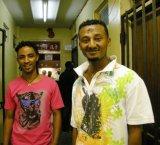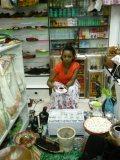Ethiopian People in Johannesburg
by Barbara on Aug.15, 2011, under Published Travel Articles
Sunday Independent 2012 January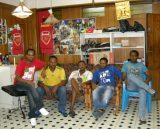 Cars howl; animated machines move, stop, disgorge people …… it is a Monday morning, the beginning of a week that may, or may not, be busy.
Cars howl; animated machines move, stop, disgorge people …… it is a Monday morning, the beginning of a week that may, or may not, be busy.
I walk down the street and into a building, people are everywhere; rainbow bales of clothing, sacks of green coffee, techno-hardware; there are voices, languages that I do not understand. I look around me, I am in Addis Ababa. I catch my thoughts, no, I am not in Ethiopia, I am not in that faraway city with its wide streets and guarded palaces; I am in a Johannesburg building; a place of business – busy-ness, the centre of the city, far from suburbs and high walls, Little Ethiopia.
Little Ethiopia stretches for roughly twenty blocks, it is squared around Von Welligh and Mooi streets. Previously these buildings were medical centres, before South Africa became free, before medicine moved to the suburbs; mahogany doors, working lifts and sick people, now it is a home for many of Ethiopia’s people, and they are not sick, they are busy. In these buildings there is movement; people dart in and out of stores carrying bags; shoppers and vendors everywhere – Zimbabwean, Ethiopian, Congolese, South African, for shoppers seek low prices, the recession bites for blood. And the people here with their aquiline features and different languages know how to do business, they know how to sell for they are traders and this is their livelihood; it is the home to one of the largest Ethiopian communities in the city.
I am in Johannesburg and yet I am not; the city is a representation of the African diaspora, where people have left arbitrary defined boundaries for what ever reason, it is also a representation of the African renaissance, Africa, it is boundary-less; divergence and connection, resemblance, memory. Johannesburg has many of the largest migratory communities in Africa, communities in that people mostly stay close to those from their country of origin; not because they do not want to mix with others, but because their own communities are recognizable; people are aware of who loves who, what feuds already exist, practise the same religion, tell the time in the same way, know relatives and friends back home. It is also safe; there is safety in having proverbial people around, only a small chance of bearing the impact of xenophobia, which is what South Africa has a reputation for. Here, in these twenty blocks, is Ethiopia, a land that has never been colonised, a diverse political, religious and ethnic country in which an array of languages are spoken, Orthodox Christians and devout Muslims live side by side; a land of exploration and art; Richard Burton entering the sacred city of Harar and Rimbaud the renegade poet from Paris selling guns to make money; it is a proud and noble country, and Ethiopians have made this part of Johannesburg their home, it is a proud and noble part of this city. And with them they have brought a sundry culture, a distinct and separate look and sound, Johannesburg a melting pot for variance, a heartbeat in Africa, it feels.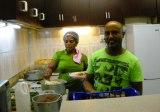
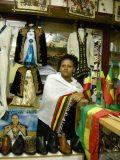
At the entrance to the building I am greeted by the sound of a krar, a six stringed lyre, an old man sits on a stool in front of a large sign, his back against a dancing meerkat, he plays the unique monophonic music of the Highlands. I stop to look and listen, his sound fuses with another, a sound more jangled but still smooth, Yohannes Sefer, who plays bolel, a fashionable, some say sarcastic, form of blues popular in Addis Ababa. With two ears I listen and then turn inside. On the first floor, I walk into the shop, which is not a shop in the conventional sense, rather slumped goods on the floor, on shelves; goods from everywhere; China, Ethiopia, America. I hear Amharic and Tigrinya, the two main languages of Ethiopia and smell frankincense.
As I wait for Netsi I look around; the walls are covered in icons of the saints, royalty – Haile Selassie stares at me, national hero’s – Abebe Bikila running barefoot on the cobbles of Rome; symbols of triumph and humbleness and victory. In a cabinet is an array of silver Coptic crosses; distinctive in their shape and decorative filigree style.
A young man walks over to me, “Hi, I am Sisay, Netsi’s brother, these are the crosses of Ethiopia,” he says, “we are not a country that has been conquered by missionaries, orthodox, that is our religion, it grew up in our country.”
As he speaks another man walks up to us, he points to a picture on the wall, “look, that is Lake Tana, where the White Nile Falls are, the Ark of the Covenant was hidden there in a monastery when it was threatened by hostilities, now it is in Aksum, you may not go inside the church for it is sacred, not even the Pope can go inside.” He puts his hand out, “I am Assebe, I have lived in South Africa for eleven years but I go back to Addis often. In Berea,” he continues, “we have an Orthodox church, if you would like to come to a service then just tell me and we can go.”
I look at the blue lake with many islands on it and then at a picture; a sloe black eyed Madonna stares at me, in her arms she holds the baby Jesus, his hair is black and curly.
I walk to another area; here they sell radios, cookery equipment and all manner of things technological. A CD player emits a voice, a story, Assebe follows me, “this,” he points to the player, “it is the story of the Queen of Sheba, it is spoken in Amharic. She journeyed to King Solomon of Israel with gifts of gold and spices, this story is told in the Bible and the Qur’an, she is the great mother to our kings, she gave birth to a child that was fathered by Solomon, he was the forbearer of our emperor, Haile Selassie, we call her Makeda.” He smiles, “we have a celebrated royal house.”
I turn back to Netsi’s shop, she is still not there. Sisay talks to me as I wait. He points to a poster above the cash register, there a long elegant runner with legs that reach into the sky breaks a tape. “Haile Gebre Selassie, we call him Emperor Gabe, he is the world’s most famous runner, he has broken twenty seven world records, and that,” he points to a poster of a woman, “that is Gelete Burka, I don’t know which records she broke but she broke many. Our runners, they make us rich as they invest in the country and they make us proud, we now have many schools and universities across the country. Do you know that Haile Gebre Selassie has an uncle that lives in Mamelodi, it is outside Pretoria, you can visit him if you want to?”
I turn and look at him; he looks back at me and laughs, ”no I am not a runner,” he says, “I am a trader, I keep fit packing and unpacking, I think my brain is also fit as I think a lot. But yes, they are so good our runners because they train at very high altitudes, Addis is very high, it is cold and the air is thin, they run up the hills and breath little air, then when they get to Europe they can beat everyone.” He laughs again, “me, I can beat everyone too.”
Netsi walks up to me, she holds a small cup of coffee, “hi,” she greets me. “Coffee is an important part of our culture,” she points to a shelf with foodstuff on it, “there are some of the beans that we bring in,” she walks over to a shelf where there are bags of green beans, “we sell it to a lot of the people who live in the area. They roast the coffee themselves in small pans for we perform the coffee ceremony daily. Anyway these are our own beans grown on the land of relatives of some of the people that live here, they ask their family to send the coffee, how much, whatever I need.”
I think of a coffee shop that I sometime visit, a trendy shop where those that believe they are erudite talk and drink coffee. It has a large coffee roaster that is imported from America, and on the walls are signs that tell me that what I drink is genuine African coffee, it supports fair trade not exploitation and greed; it is an advertisement for a fashion. Now, in this building, as I look about me, I know that I am in an area of fair trade; the term is simply differently defined.
Assebe stands next to us, ‘coffee comes from the western part of Ethiopia, Keffa,“ he says, “it is part of our culture.”
Look,” Netsi says pointing at the beans, “we have different kinds of beans; this here is Yigaceffe, put your nose here, smell it, it smells like fruit, and this, this is Sidamo, the most used ones because it is the one that we get in often, and of course the famous Harar coffee, it is sun dried.”
“I love Ethiopia,” she continues, “the food, if you want to eat it,” she laughs, “go up to my restaurant, it is on the second floor there we will give you injera, the bread that we eat with almost everything, it is made from tef which I cannot find in this country so I make it with rice flour; and also there is wat, the national dish made from spices; chilli, onions, pepper and garlic, and also kifto, this is specially prepared beef. Can I say that this is my home? No, South Africans are not hospitable, they do not invite you in for I suppose they believe that we will take something from them, jobs maybe, I don’t know, but they like it that this community is here for we bring trade and they buy from us at small prices,” she laughs again.
“I think we also bring a different Africa,” Assebe says, “a different culture and language, look,” he points at the clock, “you do not know the time for that is Ethiopian time, we have a twelve hour day and the clock runs from sunrise to sunset then it starts again, and look over there, that is our calendar, we have a thirteen month year, we do not calculate our years like you do. In your year of 2007 it was the time that we celebrated the millennium.”
“Come, sit here,” Netsi beckons to a young girl with braided hair, “this is Fitsum, my cousin, sit, we will have a coffee ceremony, you will drink our coffee, it is purifying.”
Fitsum places a charcoal burner onto the plastic grass that lies on the floor; she puts some green coffee beans into a skillet and places it on the burner. For several minutes I watch her wrists shake the skillet, then she takes it off the burner and gets up and offers the roasted beans to the people around, they smell the perfume, then she throws frankincense onto the fire. My nose excites me as the coffee and frankincense perfumes unite, for it is a perfume that I can never buy. The coffee beans are then crushed and put into a clay pot, the jebana, it is then put back on the burner. Netsi pours black liquid into a small sugary cup, “drink,” she says.
Grant walks into the shop, “hey,” he greats Netsi, and then another and another. I wait for him to finish greeting his friends and trading partners before I speak to him.
“Kaldi’s Ethiopian coffee shop is in Newtown,” he says and now we provide coffee in the restaurant upstairs. What does the person who comes to drink our coffee want, they want good Ethiopian coffee, and this is hard to find. Our biggest problem is not that people don’t want to drink our coffee, but for the market in this area, the coffee is expensive, but we have to work on ensuring that we keep going.“
A little later I leave the building, as I walk down the dirt blackened stairs brushing the shoulders of others I look through an open doorway. In a dark scented room, below the blue robes of the Madonna, I watch a woman light a brazier, she is conducting a coffee ceremony; her life in another land, and with it she brings riches to mine.
